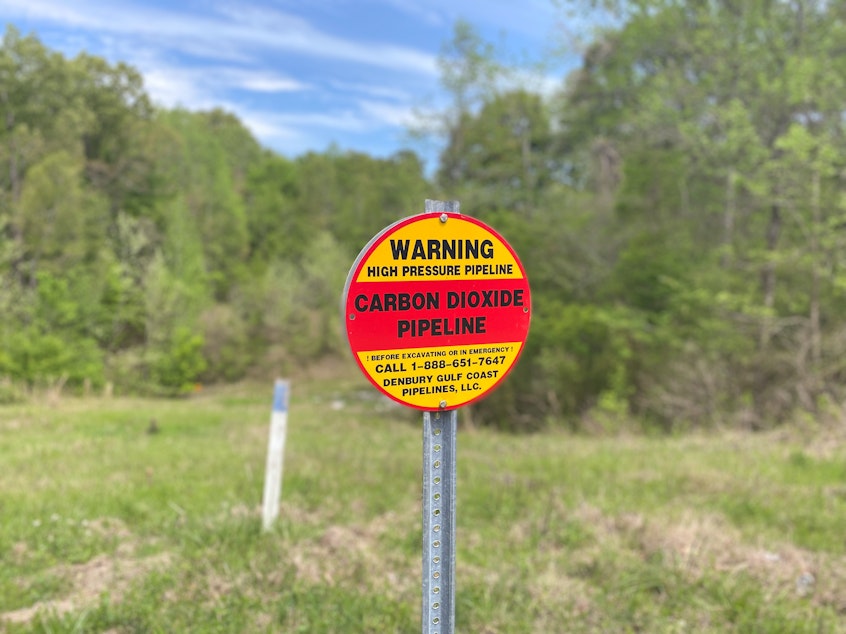The U.S. has a controversial plan to store carbon dioxide under the nation's forests

In recent years, lots of American companies have gotten behind a potential climate solution called carbon capture and storage, and the Biden administration has backed it with billions of dollars in tax incentives and direct investments. The idea is to trap planet-heating carbon dioxide from the smokestacks of factories and power plants and transport it to sites where it is injected underground and stored.
But the idea is controversial, in large part because the captured carbon dioxide would be shipped to storage sites via thousands of miles of new pipelines. Communities nationwide are pushing back against these pipeline projects and underground sites, arguing they don't want the pollution running through their land.
Now the U.S. Forest Service is proposing to change a rule to allow storing this carbon dioxide pollution under the country's national forests and grasslands. "Authorizing carbon capture and storage on NFS lands would support the Administration's goal to reduce greenhouse gas emissions by 50 percent below the 2005 levels by 2030," the proposed rule change says.
But environmental groups and researchers have concerns.
Carbon dioxide (CO2) pollution will still need to be transported to the forests via industrial pipeline for storage, says June Sekera, a research fellow with Boston University.
"To get the CO2 to the injection site in the midst of our national forest, they've got to build huge pipelines," Sekera says. "All this huge industrial infrastructure that's going to go right through."
Sekera says building those CO2 pipelines may require clearing a lot of trees.
And there are concerns about pipeline safety. If a pipeline breaks, CO2 can displace oxygen, and the plume can be hazardous to humans and anything else that breathes, says Bill Caram, executive director of the nonprofit watchdog group Pipeline Safety Trust.
In 2020, a CO2 pipeline ruptured in Satartia, Mississippi, sending at least 45 people to the hospital. Some of those people report they are still suffering from lingering health issues.
Pipeline ruptures could pose a threat for people recreating in forests – plus wildlife, says Victoria Bogdan Tejeda, attorney at the Center for Biological Diversity.
"The thing about CO2 is it's a deadly asphyxiant, whether it leaks near a town or whether it leaks near a forest," Bogdan Tejeda says.
CO2 is an odorless gas, making it harder to detect, and plumes can spread for miles. Bogdan Tejeda notes that often in national forests, there is bad cell service. "If people found themselves in trouble, they may have a hard time calling for help," she says.
And some researchers and environmental groups are concerned that the carbon capture and storage technology behind the proposed rule change is being used to extend the life of fossil fuel operations. Climate scientists say the world needs to rapidly reduce its use of fossil fuels like oil and natural gas to limit the devastating impacts caused by climate change.
Carbon capture and storage often doesn't work well, says Bruce Robertson, an independent energy finance analyst. "They are not capturing at the rates they said they would capture and they don't store at the rate they were supposed to store," he says.
An analysis of some of the world's largest carbon capture and storage projects by the Institute for Energy Economics and Financial Analysis, a nonprofit think tank, found most of them underperformed on emission reduction targets, and many were over budget.
Many of the proposed CO2 pipelines in the U.S. have faced fierce local opposition. Last month, the company Navigator CO2 canceled a proposed CO2 pipeline that would have traveled across Iowa, Nebraska, Illinois, South Dakota and part of Minnesota citing "unpredictable" state regulatory processes.
Some experts, like Sekera, question the timing of the proposed rule change, given community pushback across the country to pipelines planned on private land. She says the Forest Service proposal to open up national parks for CO2 storage is "an end run around local towns and counties. And it's a much simpler and way less expensive route."
In an email, Scott Owen, press officer for the Forest Service, writes that the proposed rule change would allow the Forest Service to consider proposals for carbon capture and storage projects.
He writes that any proposals must still pass through a secondary screening, adding: "The Forest Service has been 'screening' proposals for use of National Forest System lands for over 20 years as a means to be increasingly consistent in our processes and also be able to reject those uses that are incompatible with the management of the public's land."
He notes the Forest Service currently does not have any carbon capture project proposals under consideration.
The Forest Service has opened public comments on the proposed rule change until Jan. 2, 2024. [Copyright 2023 NPR]

